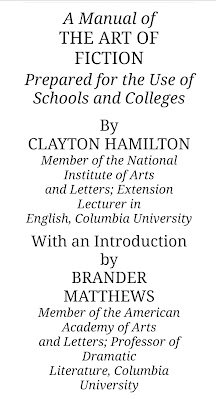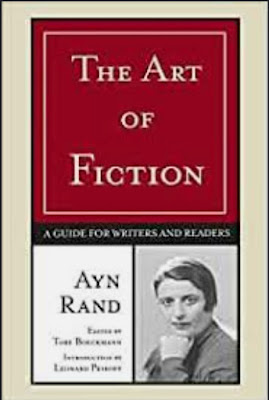A Manual of
THE ART OF FICTION
Prepared for the Use of Schools and Colleges
By
CLAYTON HAMILTON
Member of the National Institute of Arts
and Letters; Extension Lecturer in
English, Columbia University
With an Introduction by
BRANDER MATTHEWS
Member of the American Academy of Arts
and Letters; Professor of Dramatic
Literature, Columbia University
The complete classic course in the art of writing fiction.
Drawing
examples from the works of such masters as Poe, Hawthorne, and Robert
Louis Stevenson, it offers a guided course through such vital topics as
Realism, Plot, Characters, Setting, Point of View, The Epic, Structure
of the Short Story, and much more.
“Mr. Hamilton does not take to
the blue empyrean; he remains strictly below, among the definite
substrata. He burrows thoroughly and faithfully. He accomplishes a good
amount of serviceable earthwork and helps ventilate and rearrange the
general soil….Like that of the Victorians, ‘which is our chief tradition
in the novel’ – a kind of continental welter…A cultivation of the sense
of form and proportion ought to add to the reader’s pleasure, and even
to disciple him, in a measure, for the general conduct of life. A burden
shared becomes less onerous.” -Henry B. Fuller, The Dial, Volume 66,
December, 1919
Prepared for the Use of Schools and Colleges
This book is a
complete course in writing fiction. Drawing examples from the works of
such masters as Poe, Hawthorne, and Robert Louis Stevenson, it offers a
guided course through such vital topics as Realism, Plot, Characters,
Setting, Point of View, The Epic, Structure of the Short Story, and much
more.
CONTENTS
FOREWORD vii
INTRODUCTION xiii
I. THE PURPOSE OF FICTION 3
Fiction
a Means of Telling Truth—Fact and Fiction—Truth and Fact—The Search for
Truth—The Necessary Triple Process—Different Degrees of Emphasis—The
Art of Fiction and the Craft of Chemistry—Fiction and Reality—Fiction
and History—Fiction and Biography—Biography, History, and
Fiction—Fiction Which Is True—Fiction Which Is False—Casual Sins against
the Truth in Fiction—More Serious Sins against the Truth—The Futility
of the Adventitious—The Independence of Created Characters—Fiction More
True Than a Casual Report of Fact—The Exception and the Law—Truthfulness
the only Title to Immortality—Morality and Immorality in Fiction—The
Faculty of Wisdom—Wisdom and Technic—General and Particular
Experience—Extensive and Intensive Experience—The Experiencing
Nature—Curiosity and Sympathy.
II. REALISM AND ROMANCE 25
Two
Methods of Exhibiting the Truth—Every Mind Either Realistic or
Romantic—Marion Crawford's Faulty Distinction—A Second Unsatisfactory
Distinction—A Third Unsatisfactory Distinction—Bliss Perry's Negative
Definition—The True Distinction One of Method, Not of
Material—Scientific Discovery and Artistic Expression—The Testimony of
Hawthorne—A Philosophic Formula—Induction and Deduction—The Inductive
Method of the Realist—The Deductive Method of the Romantic—Realism, Like
Inductive Science, a Strictly Modern Product—Advantages of
Realism—Advantages of Romance—The Confinement of Realism—The Freedom of
Romance—Neither Method Better Than the Other—Abuses of Realism—Abuses of
Romance.
III. THE NATURE OF NARRATIVE
Transition from Material to Method—The Four Methods of Discourse—1. Argumentation; 2. Exposition; 3. Description; 4. Narration, the Natural Mood of Fiction—Series and Succession—Life Is Chronological, Art Is Logical—The Narrative Sense—The Joy of Telling Tales—The Missing of This Joy—Developing the Sense of Narrative—The Meaning of the Word ``Event''—How to Make Things Happen—The Narrative of Action—The Narrative of Character—Recapitulation.
IV. PLOT 60
Narrative
a Simplification of Life—Unity in Narrative—A Definite Objective
Point—Construction, Analytic and Synthetic—The Importance of
Structure—Elementary Narrative—Positive and Negative Events—The
Picaresque Pattern—Definition of Plot—Complication of the Network—The
Major Knot—``Beginning, Middle, and End''—The Sub-Plot—Discursive and
Compacted Narratives—Telling Much or Little of a Story—Where to Begin a
Story—Logical Sequence and Chronological Succession—Tying and
Untying—Transition to the Next Chapter.
V. CHARACTERS 77
Characters Should Be Worth Knowing—The Personal Equation of the Audience—The Universal Appeal of Great Fictitious Characters—Typical Traits—Individual Traits—The Defect of Allegory—The Defect of Caricature—Static and Kinetic Characters—Direct and Indirect Delineation—Subdivisions of Both Methods—I. Direct Delineation: 1. By Exposition; 2. By Description; [Gradual Portrayal]; 3. By Psychological Analysis; 4. By Reports from other Characters—II. Indirect Delineation: 1. By Speech; 2. By Action; 3. By Effect on other Characters; 4. By Environment.
VI. SETTING 99
Evolution of Background in the History of Painting—The First Stage—The Second Stage—The Third Stage—Similar Evolution of Setting in the History of Fiction: The First Stage—The Second Stage—The Third Stage: 1. Setting as an Aid to Action—2. Setting as an Aid to Characterization—Emotional Harmony in Setting—The Pathetic Fallacy—Emotional Contrast in Setting—Irony in Setting—Artistic and Philosophical Employment—1. Setting as a Motive toward Action—2. Setting as an Influence on Character—Setting as the Hero of the Narrative—Uses of the Weather—Romantic and Realistic Settings—A Romantic Setting by Edgar Allan Poe—A Realistic Setting by George Eliot—The Quality of Atmosphere, or Local Color—Recapitulation.
VII. THE POINT OF VIEW IN NARRATIVE 120
The Importance of the Point of View—Two Classes, The Internal and the External—I. Subdivisions of the First Class: 1. The Point of View of the Leading Actor; 2. The Point of View of Some Subsidiary Actor; 3. The Points of View of Different Actors; 4. The Epistolary Point of View.—II. Subdivisions of the Second Class:—1. The Omniscient Point of View; 2. The Limited Point of View; 3. The Rigidly Restricted Point of View—Two Tones of Narrative, Impersonal and Personal: 1. The Impersonal Tone; 2. The Personal Tone—The Point of View as a Factor in Construction—The Point of View as the Hero of the Narrative.
VIII. EMPHASIS IN NARRATIVE 139
Essential
and Contributory Features—Art Distinguishes Between the Two by
Emphasis—Many Technical Devices: 1. Emphasis by Terminal Position; 2.
Emphasis by Initial Position; 3. Emphasis by Pause [Further Discussion
of Emphasis by Position]; 4. Emphasis by Direct Proportion; 5. Emphasis
by Inverse Proportion; 6. Emphasis by Iteration; 7. Emphasis by
Antithesis; 8. Emphasis by Climax; 9. Emphasis by Surprise; 10. Emphasis
by Suspense; 11. Emphasis by Imitative Movement.
IX. THE EPIC, THE DRAMA, AND THE NOVEL 157
Fiction a Generic Term—Narrative in Verse and Narrative in Prose—Three Moods of Fiction: I. The Epic Mood—II. The Dramatic Mood: 1. Influence of the Actor; 2. Influence of the Theatre; 3. Influence of the Audience—[Dramatized Novels]—III. The Novelistic Mood.
X. THE NOVEL, THE NOVELETTE, AND THE SHORT-STORY 172
Novel,
Novelette, and Short-Story—The Novel and the Novelette—The Short-Story a
Distinct Type—The Dictum of Poe—The Formula of Brander
Matthews—Definition of the Short-Story—Explanation of This Definition:
1. ``Single Narrative Effect''; 2. ``Greatest Economy of Means''; and 3.
``Utmost Emphasis''—Brief Tales That Are Not
Short-Stories—Short-Stories That Are Not Brief—Bliss Perry's
Annotations—The Novelist and the Writer of Short-Stories—The Short-Story
More Artistic Than the Novel—The Short-Story Almost Necessarily
Romantic.
XI. THE STRUCTURE OF THE SHORT-STORY 189
Only
One Best Way to Construct a Short-Story—Problems of Short-Story
Construction—The Initial Position—The Terminal Position—Poe's Analysis
of ``The Raven''—Analysis of ``Ligeia''—Analysis of ``The Prodigal
Son''—Style Essential to the Short-Story.
XII. THE FACTOR OF STYLE 207
Structure and Style—Style a Matter of Feeling—Style an Absolute Quality—The Twofold Appeal of Language—Concrete Examples—Onomatopoetic Words—Memorable Words—The Patterning of Syllables—Stevenson on Style—The Pattern of Rhythm—The Pattern of Literation—Style a Fine Art—Style an Important Aid to Fiction—The Heresy of the Accidental—Style an Intuitive Quality—Methods and Materials—Content and Form—The Fusion of Both Elements—The Author's Personality—Recapitulation.
Also see:
The PDF might take a minute to load. Or, click to download PDF.
If your Web browser is not configured to display PDF files. No worries, just click here to download the PDF file.



.jpg)





